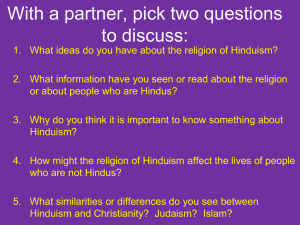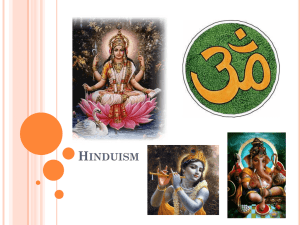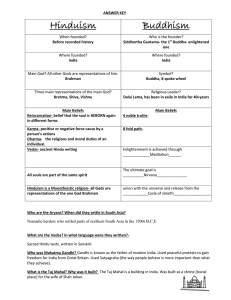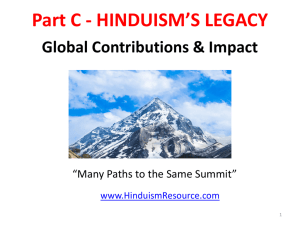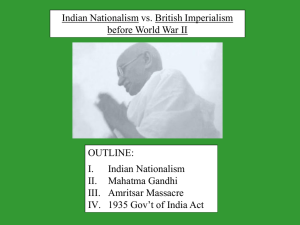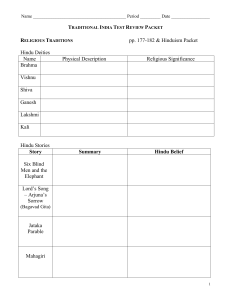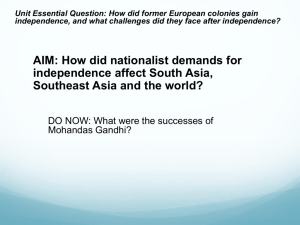Heritage of South Asia Chapter 8
advertisement
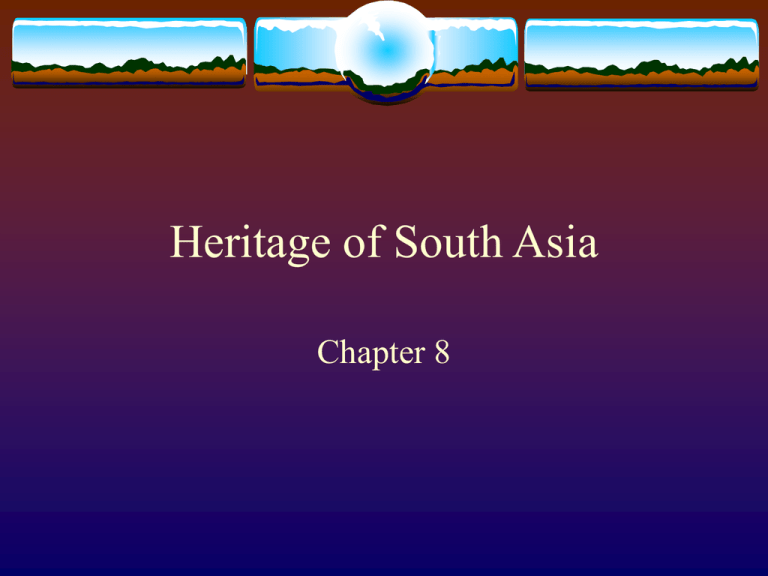
Heritage of South Asia Chapter 8 Hinduism Chief religion of India No founder No formal church Hinduism A way of life Shapes and unifies Indian culture Sacred Texts Vedas Contain the eternal truths that were revealed to the wise men. Hindu scriptures. Oldest sacred texts of Hinduism. Upanishads Explains ideas contained in the Vedas Sacred Texts Ramayana Mahabharata Epic poems that explain the law codes of Hinduism. Brahman Hindus worship thousands of Gods ALL GODS Brahman are contained in ONE FORCE Brahman Only a few can truly understand Brahman Characteristics Nameless Formless Unlimited of Brahman: Three Main Gods of Hinduism (The Hindu Trinity) Brahma Vishnu Siva Brahma The Creator Vishnu Preserver Siva Destroyer Sects Sect – a religious group A sect Many of Hinduism would mean a (what?) within Hinduism? Sects of Hinduism Different “Such Page sects worship different Gods. Perfection” R.K. Narayan 240 Atman Every person has an essential self. This self is part of a universal soul - Atman Atman In all things Upanishad Essential An teaches: self in humans is no different than that of: ant A gnat An elephant Hindu Belief Atman = Brahman Because Atman Hindus NON is in ALL THINGS: believe: VIOLENCE RESPECT NATURE Hindu Beliefs Suffering: Pain and Sorrow Why? False People pursue false goals Goals: Material wealth Personal pleasure Hindu Beliefs Goal of Life: Moksha Freeing of the soul from the body so that the soul can unite with Brahman. Cannot be achieved in one lifetime Reincarnation Reincarnation – a rebirth After the body dies, the soul is reborn as anything from a god to a flower to as snake. This form is only TEMPORARY Karma Cycle of birth and death continues until the soul reaches Brahman. (or union with Brahma) This release is determined by KARMA. Karma – From the Sanskrit meaning “to do” Law – every deed—mental or physical—in this life affects a person’s present situation is the result of his or her deeds in a past existence. Good deed = happiness Bad deed = sorrow Review Karma Reincarnation Brahman 3 Gods of Hindu Trinity Sacred Texts Hinduism – founding? Formal church? The Caste System Based on the idea that there are separate kinds of humans. Higher Caste- (pure) closer to Moksha Lower Caste- (impure) away from Moksha Caste System Based on occupation New castes are created to adapt to change. New occupations Technology Transportation New arrivals may be absorbed into an existing caste, or, depending on the occupation and numbers, be part of forming a new one. Rules Purpose: Highest In Help people remain spiritually pure. Caste = Strictest Rules relation to purity, this makes sense. The purest caste should have the strictest rules. Contact with other castes High Caste Contact with lower castes creates a risk of possible spiritual impurity for the high caste. Even contact with a shadow Some members of low castes have to warn people in advance of their presence. Wooden clapper Caste Rules Govern: Cooking Cleaning Eating habits Marriage Employment Marriage Brahman must marry a Brahman We see this changing in India For the most part remains true. Think of applying this to American culture. Interdependence Castes No look after their own members caste can do the work of another. Caste System based on: Law Custom Tradition – acceptance Cannot interfere. Village and Family Life Indians identify with both. Family always before village. Family Life: THE JOINT FAMILY – an extended family. Includes: husband, wife, their sons with their wives and children, and unmarried daughters. the husband’s brothers, uncles, and cousins might also live under the same rooms. Patriarchal “Father” The oldest male. Thought to be most knowledgable. Makes the decisions. Marriage Arranged marriages Bride’s families pay most of expenses Might Dowry groom. go into debt for a marriage. – a gift of money or goods paid to the Women Skakti – creative energy. Women – seen as dangerous unless ruled by man. Purdah- complete seclusion. Higher caste rule Wear veils Sati – Virtuous woman. Indus Valley Civilization – 1,500 BCE Indus River (Pakistan) Planned Cities: 2,500 Harrapa and Mohenjo Daro Checkerboard Strong pattern of streets. urban planning suggests a strong government. Farming Taxes collected Taxes came in the form of food. Barley/ Wheat/ Peas/ Sesame. Cattle/ Sheep/ Goats/ Water buffaloes. Indus Valley Civilization Form of writing: Picture writing Religion: Believed Important Priests in a mother Goddess members of society: were important individuals within society. Trade Traded within middle-east EXPORT: Cotton / Ideas The Decline Indus Valley Civilization Believed: Natural Causes – climate became too dry Towns abandoned Bricks no longer uniform size Streets no longer repaired. What might one infer about the strength of government? Without food to pay taxes = no funding for government. Aryans 1500-500 BCE Gradually moved into Indus Valley Invaders? Characteristics: Light skinned Began in Caucus Mountains Aryans Vedas: oral/written tradition (hymns/prayers/rituals used in religious practices) Information historians know is derived from Vedas. Religious beliefs: Polytheistic Vedas = Holy texts Beginnings of Hinduism Establish the Caste System Involved religious sacrifices of food and water to the Gods. Swastika – an Aryan symbol – Hitler wanted to build an Aryan race. Aryans Farmers & Herders GREAT value on cattle Men received cattle as reward for good work (as in success in war) Wealth – measured in terms of cattle. Vedas – Demonstrate importance of cow. Cow’s milk like rain to the earth War = translates “let’s go get some cows” Aryans Villages – hereditary chiefs that ruled Aryan villages. Rajahs Council of warriors at his disposal. Aryans Social Classes 4 Basic Classes = the VARNA Brahmans Kshatriyas Warriors Vaisyas –Priests Landowners/ Merchants/ Herders Sudras Servants/ Peasants Aryans Vedas Hymn Divides the four classes from a human. Brahmans Kshatriyas Arms (Warrior) Vaisya Mouth Thighs Sudra Feet Aryan Sanskrit – ancient language developed by the Aryans (Greek or Latin) – other examples of ancient languages. Review Harappa Mohenjo-Daro Sanskrit The Maurya Empire Chandagupta Maurya First ruler of the Maurya Empire Why important? Began the Maurya Dynasty Ruled India for 140 years Dynasty – ruling family. The Maurya Empire Government – capital Mighty wooden wall 570 guard towers 64 gates Pataliputra Chandragupta never slept in the same bed twice. Chandragupta Enjoyed peace Trade Irrigation systems Maintained roads Asoka Reforms/Changes Grandson of Chandragupta Brought Maurya Empire to the height of its power. Asoka Asoka’s Transformation Beginning of rule: Ruled harshly. Waged War. 100,000 killed under his rule. End of rule: Sickened by bloodshed, Asoka converted to Bhudism and practiced non-violence. The end of his rule was kind and benevolent, with little force. Asoka Worked to improve lives of people. “All men are my children. As on behalf of my own children I desire that they may be provided by me with complete welfare and happiness in this world and in the next, so do I desire for all men as well” ASOKA – spread Buddhism and ordered the building of thousands of stupas. Stupa – shrine containing remains of the Buddha. The Fall of the Maurya Empire Asoka’s Invaders death led to the fall of the Maurya Empire. moved into the land. Invader’s ideas, customs, culture was absorbed into Hindu culture. The Gupta Empire Chandragupta I Young warrior. Purposely wanted to link his name with the ancient Chandragupta. Achievements: Art, literature, math. Indian scholars developed the concept of “0.” The Decline Gupta Empire declines: Huns and Central Asian powers invaded South Asia. Arrival marked the end of the Gupta Empire. A Clash of Beliefs: Muslims vs. Hindus Islam was based on belief in one God. Hindus worshipped many Gods. Islam taught that all Muslims were equal under God and Hinduism promoted the Caste System. The Mughal Empire The reign of Akbar Realized that to rule India he must rule BOTH Muslims and Hindus. How? Religious toleration. Marries a Hindu (he was Muslim) Abolished a special tax on Hindus. Appointed Hindus to jobs in government. LEGACY: today Hindus honor Akbar as a MASTER OF COMPROMISE The Arts Hindu Shah and Islamic styled blended. Jahan (Akbar’s grandson) A monument to Mumtaz Muhal (Shah Jahan’s wife) The Decline of the Mughal Empire Wasteful Spending Akbar’s successor (new rulers) ended his policy of toleration Imposed heavy taxes on Hinduism. Closed Hindu schools. Dismissed Hindus from government. This led to Civil War and Revolts throughout the country. Essay Explain the goal of life for Hindus. How is this goal achieved? What are signs that one is moving toward this goal? Explain in detail and be sure to use and explain proper terminology. Review Activity Write out 5 questions based on Civilization. In groups of 3, share your questions with the group, have other members of the group respond. IT WOULD BE A GOOD IDEA TO WRITE DOWN OTHER QUESTIONS. India Under British Rule Vasco Da Gama Portuguese explorer. First European explorer to reach India. 1498 Vasco Da Gamma The Portuguese in India 2 Motives: 1) Trade 2) Christianize Wealth of trading oppurtunities Emeralds; Multitude To rubies; spices of people be “saved” / Christianized Monopoly Complete control over a market or product. The Portuguese had a monopoly until the Dutch broke into their trade. The English and French would be soon to follow. The British East India Company Established 1600 Set up trading posts at Madras; Bombay; Calcutta. Trading: England traded: Gold and silver to India India traded: Cotton, silk, and tea to England A Struggle for Power The decline of the Mughal Empire: A war Britain and France competed to control India’s small kingdoms that arose as the empire declined. for empire! France vs. Britain Britain emerged victorious. East India Company Rule Robert Clive Led the British to victory. Individual kingdoms throughout India still existed. British promoted tension and rivalries amongst the different kingdoms Why would the British encourage this? East India Company Rule British rule: Collected taxes Set up rules Outlawed Hindu traditions. Ritual suicide of Hindu widows. Outlawed Hindu customs Christian missionaries tried to convert Indians to Christianity. Indian Reaction Did not like foreign influence. Did not want foreigners dictating how to live. The Sepoy Rebellion Sepoys – Indian troops that served in the British Army Cartridges in rifles were greased with beef or pork fat. Hindu Belief – Cows are sacred Muslims were forbidden to touch pork. A New Law: required Sepoys to travel to fight for the British Army. Their was concern that Caste might be lost if they traveled outside of India. Sepoys rebel in northern and central India. British put down the rebellion. Sepoy Rebellion Will lead to several key political changes in India Most important: India will be taken over as a British Colony Queen Victoria – Empress of India Queen Victoria Lasting Effects Sepoy Rebellion British ruled India directly ¾ of India remained under the control of local Kingdoms, however, rulers had to sign treaties giving control of foreign affairs to the British. Distrust Lasting distrust between British and Indians. Indians resented British efforts to change their culture. “Europeans Only” Benches Train cars But it was a foreing country, this reminded Indians of their resentment. Effects of British Rule British: Improved Transportation Communication Improved roads Modernized ports Improved telegraph systems Build railroads Why Improve India? The modernization allowed Britain to increase its control over India Messages of revolt traveled quicker. Troops could be transported faster. Effects of British Rule Economic Industrial To Revolution end competition with Indian manufacturers: Laws made that outlawed the importation of Indian goods to Britain. Indian manufacturers went out of Business Indians were forced to by more expensive British goods. Effects of British Rule Economic To pay for British goods: Indian farmers had to stop growing food crops and replace them with the agricultural needs of the British. British Imported: Tea Pepper Coffee Cotton Because no food was produced this caused famines in some parts of India. Effects of British Rule Social Improved: Healthcare Sanitary conditions Cities This led to a growth in the population of India Effects of British Rule Education High Caste Educated in colleges and schools Taught English, Taught British political thought, British culture. Ideas such as: Liberty; freedom; and rule by the consent of the governed. Why might these ideas cause problems for Britain? Indian Nationalism STRONGEST AMONGST HIGH CLASS Resulted from good education. But what should India look like after reform? Hindu, traditional India? Or Modernized western India? Response: A blend of both. Indian Nationalism Indian National Congress 1885 Mostly HINDU Called for gradual change Asked British to give more government jobs to Indians – after WWI – INC takes a more forceful approach. 1920 Mohandas Ghandi United large sections of India together in support of home rule. Pressured Britain for self-rule. Britain gave into pressure, promising that, in time, Britain would allow India its independence. Muslim Concern Hindu nationalism grew. Muhammad Ali Jinnah Found of the: Muslim League Believed the subcontinent must be divided into two separate countries. Review Sepoy Rebellion East India Company Monopoly Robert Clive Sepoy Muhammad Ali Jinnah Muslim League Mohandas Ghandi Indian National Congress British Social and Economic influenced on India Freedom and Partition Mohandas Gandhi Leader of India’s independence movement. MUST ONLY use peaceful means to achieve independence. Without violence, what are ways Gandhi could help India achieve independence? Growing Unrest Indian Nationalism Increased demands for freedom before, during, and after WWI. 1919 British response: Harsh rights. new laws limiting freedom of press and other General Reginald Dyer 5 British officials killed during nationalist protests in India. Dyer’s Response: BANNED ALL public gatherings How might Dyer perceived this as a solution to the problem? Do you believe it was successful? Defiance of Dyer Indian Nationalism Determined to defy Dyer’s order April 13, 1919 10,000 Indian Nationalists gathered in a public area in Amritsar (a city in northwestern India) General Dyer’s Response “The Butcher” Ordered his troops to open fire. Men; Women; Children Trampled 379 as they tried to escape. killed 1,100 injured Mohandas Gandhi Returned to India from South Africa in 1914 A key figure in the struggle for India’s independence. He was able to unite most Indians behind the cause of independence. Gandhi’s Principles Came from a middle-class Hindu family. Little success as a lawyer Moved to South Africa to practice law. South Africa: Where Gandhi developed his idea for the use of nonviolent resistance to solved injustice. Gandhi’s Principles Gandhi's principles derived from three sources: Hinduism Respect for Life; Nonviolence. Christianity Love; Henry Civil Love one’s enemy David Thoreau Disobedience Satyagraha First Principle “truth force” The use of nonviolent resistance to solve injustice. Civil Disobedience The refusal to obey unjust laws. Satyagraha Goal: Convert Hoped the wrong doer. to make the world aware of the British injustice by accepting punishment without striking back. Gandhi’s Appeal Stressed India’s rich heritage. Gave up western ways. Encouraged traditional Indian industries. Spinning cotton Lived simply. Dressed simply. Identified with India’s poor. Gandhi Vegetarian Often fasted and went without food. Emphasized Hindu virtues such as self discipline. “Mahatma” = “great soul” Campaign of Civil Disobedience Gandhi traveled India: Urged nonviolent resistance Forms: Strikes Protests Boycotts The Salt March Satyagraha – in action Gandhi used Satyagraha to protest the tax on salt. British forbade Indians from making salt This was a way to control the populace of India The Salt March 200 mile march from his home to the coast. Gandhi and 50,000 others arrested. Civil Disobedience: made salt. Government response: keeps salt tax Overall outcome: Increased support for Indian nationalists. The Hindu-Muslim Conflict Hindus and Muslims had cooperated for independence up into the 1920’s… With British encouraging conflict: Began in 1930’s Hindu Congress Party Viewed Muslims as foreign conquerors Muslim League Muhammad Ali Jinnah Demanded a separate Muslim Nation Gandhi – wanted a unified India Subcontinent Divided 1946 Rioting between Hindus and Muslims Britain realized: Civil War would break out if something was not done. INDIAN As INDEPENDENCE a result of Hindu-Muslim conflict. CREATED TWO SEPARATE NATIONS India & Pakistan India Hindu majority Pakistan Muslim majority Leadership Jawaharlal Nehru First Prime Minister of India Muhammad Al Jinnah Governor of Pakistan Violence Partition Explosion of violence Distrust and Fear of the other 500,000 people killed Mass Migration To escape massacre: Hindus in Pakistan fled to India. Muslims in India fled to Pakistan. Mahatma Gandhi Sickened by violence. Refused to celebrate Indian Independence Independence – August 15, 1947 January 1948 Extremist – believing Gandhi abandoned their cause, assassinated Gandhi. Hindu Modern India An Overview India and Pakistan become independent from Britain in 1947 Millions migrate Pakistan – Muslim India – Hindu A as much as a million people die in violence Jawaharlal Nehru Prime Minister of India (1947-64) Integrated princely states into India Jawaharlal Nehru Fought first Indo-Pakistani War (1947-1948) Hindu prince of Kashmir, a Muslim dominated territory, chooses to join India. Pakistan invades and is stopped by India Kashmir is split between India and Pakistan 3 more wars follow: 1965; 1971; 1999 Jawaharlal Nehru New constitution adopted India becomes a multi-state Parliamentary democracy. Largest democracy in the world. Jawaharlal Nehru Economic: Pursues socialist economic policies Nationalizes (government takeover) major industries. Develops industry; agriculture; and infrastructure. Social: Promotes education Improves rights of women in lower castes. Jawaharlal Nehru International Affairs Non-alignment Didn’t Movement during the Cold War ally with US or USSR Death: Dies of natural causes in 1964 while still in power. Indira Gandhi Prime Minister of India (1966-77, 1980-84) Nehru’s daughter, no relation to Mohandas Helps Bangladesh win independence in Third Indo-Pakistani War (1971) East Pakistan devastated by a cyclone West Pakistan dominated government responds slowly. Indira Gandhi Sides with Soviet Union in Cold War Tests a “peaceful” nuclear bomb in 1974. Improves agriculture with the “Green Revolution” and “Operation Flood” Indira Gandhi Indira the Dictator: Found guilty of election irregularities Faced protests and strikes Declares a state of emergency and suspends civil liberties. Loses election of 1977 (win in 1980) Indira Gandhi Faces Sikh separatist movement in Punjab region. Raids Golden Temple in Amritsar Sikh resistance crushed Death: Indira killed by two of her own Sikh bodyguards. Rajiv Gandhi Prime Minister of India (1984-89) Son of Indira Encourages capitalist reforms and foreign investment. Encourages science and technology Telecommunications, computing, space program Rajiv Gandhi Brokers peace deal in Sri Lanka between government and Tamil rebels Sends peacekeeping troops Ends up fighting rebels India later withdraws Rajiv Gandhi Loses image as “Mr. Clean” after scandal Government officials took bribes over military contracts. Lost election in 1989 Assassinated by female Tamil suicide bomber while campaigning in 1991. Sonia Gandhi Rajiv’s Italian born wife. President of Congress Party Congress Party has held power for most of India's history and currently rules. Current Prime Minister is Manmohan Sing A Sikh doctor Essay Question Explain Gandhi’s satyagraha. How did Gandhi combine Christian and Hindu ideas to form the concept of satyagraha? Provide three specific examples (from either the movie or notes) of how Gandhi put satyagraha into practice and explain how satyagraha fits the example.
